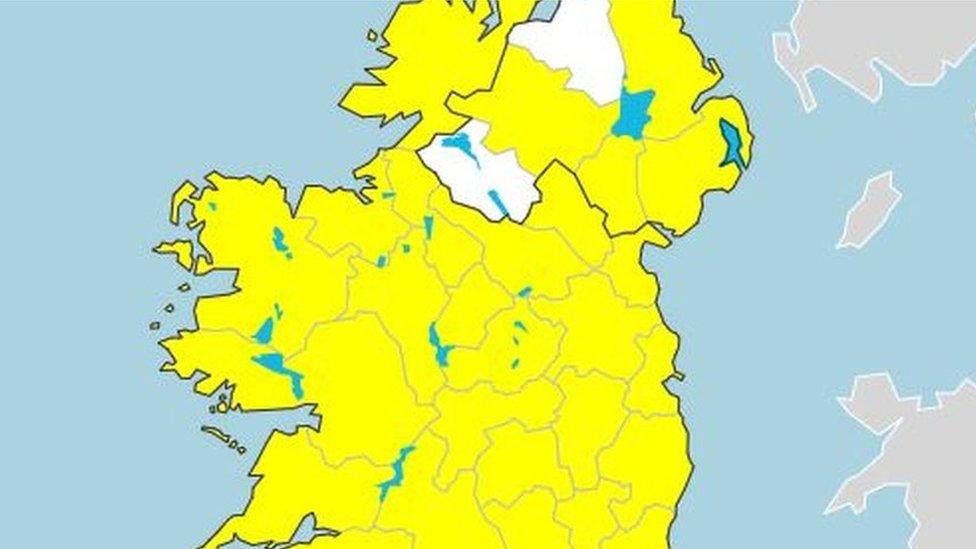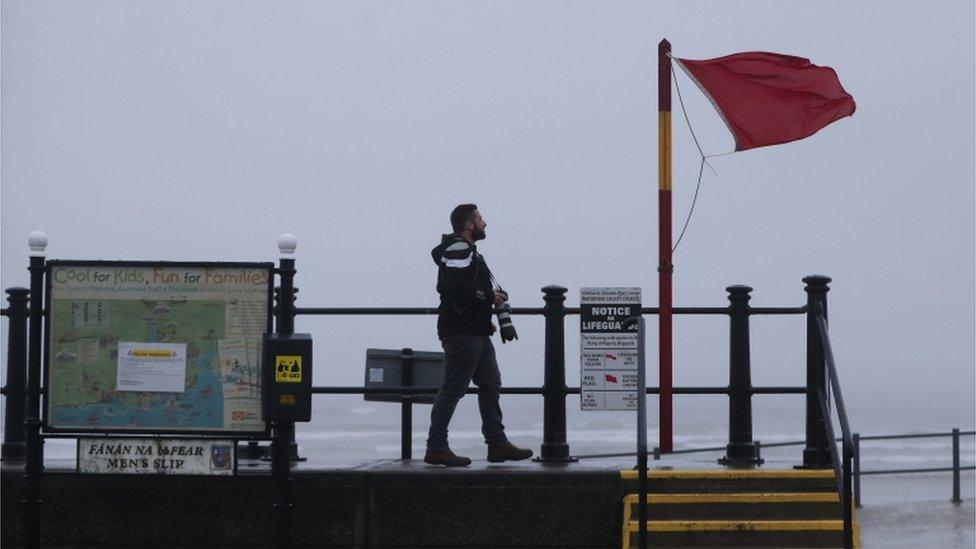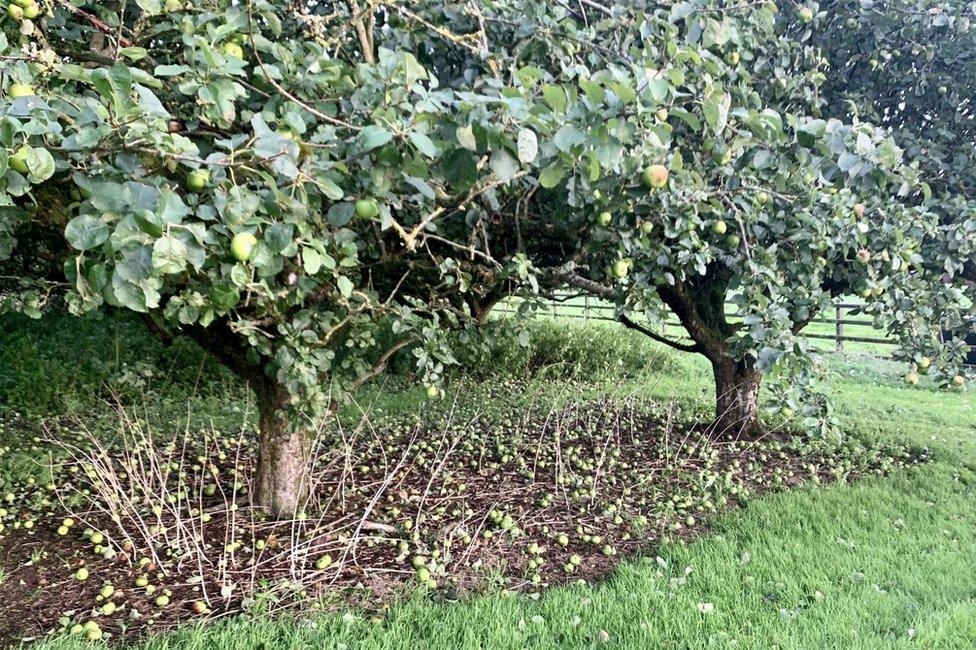Storm Ellen: Northern Ireland avoids worst of high winds and rain
- Published
- comments

Warnings for wind remain in place across the island
Northern Ireland escaped the worst of Storm Ellen, but high winds and heavy rain caused damage in southern parts of the island.
Several roads across Northern Ireland were blocked by fallen trees, with 99 households affected by power cuts as of 20:00 BST on Thursday.
TrafficwatchNI, external reported fallen trees in all six counties in Northern Ireland, with County Fermanagh worst affected.
In the Republic, 50,000 customers will remain without power on Thursday night.
In a statement, power supplier ESB Networks said crews had restored power to about 140,000 customers over the course of the day and would mobilise again "at first light" to restore power to the remainder on Friday.
Southern, western and midland counties in the Republic of Ireland bore the brunt of the storm, but County Cork saw the strongest winds and coastal flooding.
A new yellow weather warning for wind has been issued by the Met Office.
It covers eastern parts of Northern Ireland and is in effect until 04:00 BST on Friday.
Ireland's meteorological service Met Éireann's weather warnings are based on different criteria, with a yellow warning for wind in place for all counties except Tyrone and Londonderry from Thursday evening until 05:00 on Friday.
In County Fermanagh, six people were rescued from two boats at Devenish Island when the vessels began breaking their moorings in the early hours of the morning.
Enniskillen RNLI said its volunteers secured the boats and brought all six people safely into Enniskillen on its lifeboat.
Allow X content?
This article contains content provided by X. We ask for your permission before anything is loaded, as they may be using cookies and other technologies. You may want to read X’s cookie policy, external and privacy policy, external before accepting. To view this content choose ‘accept and continue’.

Ahead of the storm's arrival, Ireland's meteorological service Met Éireann had issued its highest level weather warning - status red - for County Cork and advised people to remain indoors.

Analysis: August records set during Storm Ellen
By BBC News NI Weather Presenter Barra Best
Early figures from Met Éireann suggest Storm Ellen set new weather records in the Republic of Ireland for the month of August.
The storm brought the lowest mean sea-level pressure on record with 966.4msl at Athenry, County Galway. The previous record was 967.8msl at Belmullet, County Mayo in 1959.
The highest 10 minute wind speed record was also broken with 111km/h (69mph) recorded at Roche's Point in County Cork, beating the previous record of 111km/h at Malin Head in County Donegal in 1973.
The figures show that the second-highest wind gust for the month of August was also recorded at Roche's point at 143km/h (89mph).
That was marginally beaten by the 144km/h (90mph) recorded at Claremorris in County Mayo in 1999.

Several parts of Cork saw flooding, including Skibbereen, Kinsale, Middleton and Bantry, while waves spilled over the seafront wall at Youghal.
Skibbereen experienced heavy flooding in the town centre after intense rainfall.
In a tweet, Fianna Fáil TD for Cork South West, Christopher O'Sullivan, said: "This shouldn't be happening in Skibbereen. Millions spent on flood protection. The entire town should be dry even in this intense rainfall."
Allow X content?
This article contains content provided by X. We ask for your permission before anything is loaded, as they may be using cookies and other technologies. You may want to read X’s cookie policy, external and privacy policy, external before accepting. To view this content choose ‘accept and continue’.
Cork also recorded the highest inland winds, with gust reaching 89mph (143km/h) at Roches Point.
In Northern Ireland, Thomastown in County Fermanagh topped the list with gusts of 62mph (100km/h).
Colin Robinson in Whitehead, County Antrim recorded large waves along the town's seafront.
Allow X content?
This article contains content provided by X. We ask for your permission before anything is loaded, as they may be using cookies and other technologies. You may want to read X’s cookie policy, external and privacy policy, external before accepting. To view this content choose ‘accept and continue’.
Out to sea, gusts of up to 112mph (180km/h) were recorded from a buoy off the southern coast of the island.

Strong winds were also seen a Tramore beach in County Waterford
The Republic of Ireland's electricity operator, ESB Networks, said gale force winds had caused significant and widespread damage to the electricity network, "affecting more than 194,000 homes, farms and businesses".
"Approximately 40,000 homes, farms and businesses in Cork city and county are without power," ESB added.
"The damage is mainly attributable to fallen as a result of the high winds."
In Northern Ireland, the Met Office had issued a yellow warning for strong winds.

Storm Ellen left a carpet of apples at this orchard in Tullysaran, County Armagh
The Police Service of Northern Ireland tweeted on Thursday morning that it had received reports of a number of fallen trees and debris lying on roads.
It said the Roads Service had been informed, but warned drivers to take care.
The latest information on power cuts in Northern Ireland can be accessed on NIE Network's website. , external
Allow X content?
This article contains content provided by X. We ask for your permission before anything is loaded, as they may be using cookies and other technologies. You may want to read X’s cookie policy, external and privacy policy, external before accepting. To view this content choose ‘accept and continue’.

BBC NI weather forecaster Cecilia Daly said winds will ease later on Thursday morning, leaving dry conditions for a brief period.
However, heavy showers are forecast from Thursday afternoon onwards, with a risk of thunder and lightning and more strong winds.
The latest information on power cuts in Northern Ireland can be accessed on NIE Network's website. , external